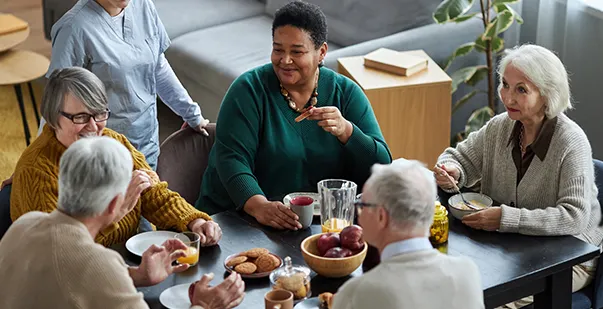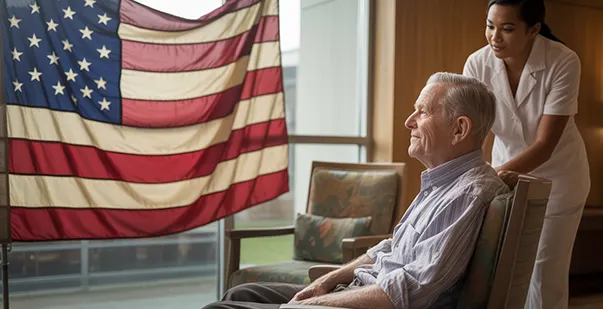Many veterans face unique challenges as they age, from mobility issues to health conditions like PTSD or chronic pain. Assisted living facilities for veterans provide the support they need while allowing them to maintain independence. These facilities offer medical care, daily assistance, and a sense of community with fellow veterans. The demand for such care is rising. As more veterans grow older, many struggle with everyday tasks, and family members may not always be able to provide full-time support. Assisted living bridges this gap, ensuring they receive proper care in a comfortable and respectful environment.
Beyond medical help, these facilities create camaraderie. Veterans can share experiences, build friendships, and engage in activities designed for their well-being. Read on to learn why the need for VA assisted living is growing day by day and what benefits they offer.
Read More: What Is An Assisted Living Facility? Costs, Benefits And Services
What Are Assisted Living Facilities for Veterans?
Assisted living facilities for veterans provide personalized care to the elderly and disabled veterans. These facilities offer a structured environment with trained caregivers who help with daily activities, medical needs, and social engagement. Based on individual requirements, veterans can access different services to ensure that they receive specialized care suited to their needs.
Personal Care: Trained caregivers aid veterans with everyday activities, including bathing, dressing, toileting, and eating. Some homes will provide medical professionals to come to visit.
Medical Care: Most assisted living facilities are not hospitals, but they do hire nurses and often work in collaboration with healthcare professionals in managing medication, physical therapy, and medical treatments.
Mental Health Services: Some facilities offer services for patients with PTSD, depression, or substance use disorder. The provided services may consist of therapy for the veteran as well as the family.
Household Chore Services: Staff provide household chores that include cleaning and laundry, also ensuring maintenance that will keep it safe and habitable.
Local Adult Day Care: Veterans may not be required to stay in an assisted living facility the whole time but spend their days at these centers receiving care, meals, and participating in social activities.
Respite Care: Temporary care services offer a break in family caregivers so that veterans receive professional help during a specific time.
Why is The Demand for VA Assisted Living Facilities Growing?
There are various factors behind the rising demand for assisted living facilities among veterans. One of the most common reasons is the aging veteran population. According to the U.S. Census Bureau, there are more than 16 million veterans in the country, with a large proportion of them older than 65 years. This demographic shift has shown the need for specialized care facilities. Some other significant reasons for this growing demand are as follows:
Read More: What Are Residential Assisted Living Facilities?
Many veterans suffer from long-term diseases due to their military work. They commonly face traumatic brain injury (TBI), Post-traumatic stress disorder (PTSD), and other physical disabilities. For this population, assisted living facilities can offer round-the-clock medical and personal care.
Psychological Problems And Isolation
Many veterans, as they get older, find loneliness and depression as common issues. Especially when they are living alone. Assisted living facilities can provide them with an environment that encourages socialization, making new relations, and removing isolation.
Many veterans cannot afford to pay for private care. The VA assisted living facility offers support to these veterans and provides cost-effective options. This helps veterans receive the required care without any financial burden.
Family dynamics also influence this increasing demand. Aging veterans may need a high level of care that families cannot provide. This is where assisted living facilities offer professional care in the comfort of a veteran's home. Such facilities also promote healthy relationships among family members without the burdens of caregiving responsibilities.
Read More: How Much Does Assisted Living Cost?
Benefits of Assisted Living Facilities for Veterans
Aging veterans need an environment that supports their emotional and social well-being. Assisted living facilities create opportunities for engagement, companionship, and fulfilling daily experiences. The benefits VA assisted living facilities provide to veterans are as follows:
Access to Special Healthcare
Assisted living facilities for veterans employ staff who are trained to understand the unique healthcare needs of veterans. They get holistic care with attention to detail based on experience. They are well taken care of in terms of chronic conditions, and mental health support is given.
Camaraderie and Socialization
Veterans often have much in common, and they can bond over their history. This makes socialization an important aspect of enhancing their mental health and removing the feeling of alienation. These communities organize group activities, discussion circles, and outings, which help veterans connect with peers who understand their journey.
Personalized Care Programs
Assisted living facilities for veterans provide personalized care programs. The staff assesses the requirements of each veteran to develop a personalized care plan. This ensures that veterans receive the specific type of care they need, such as medical attention, physical therapy, and assistance in activities of daily life.
Safe and Accessible Living Spaces
Veterans with mobility challenges need secure environments. Assisted living facilities are designed with accessible rooms, fall prevention measures, and round-the-clock staff assistance to ensure safety and comfort.
Recreational And Therapeutic Activities
Facilities offer a range of activities, including exercise programs, art therapy, music therapy, and gardening. These activities keep veterans engaged, promote mental stimulation, and improve physical health.
Catering To Nutritional Needs
Assisted living facilities for veterans also cater to the nutritional needs of veterans effectively. Veterans are provided with proper nutrition through balanced food that is customized according to their various health conditions. This concentration on nutritional needs can also help in the control of chronic conditions and enhance their overall well-being.
Support During Depression And Stress Disorder
Some of the main problems that many veterans face are depression and post-traumatic stress disorder (PTSD). Assisted living facilities make it possible for veterans to live with these obstacles with the presence of mental health professionals and their support groups. The emotional recovery of these individuals depends upon the availability of counseling and rehabilitation services in the assisted living facility.
Teaching And Advocacy Entity
Assisted living facilities for veterans serve as a teaching and advocacy entity. They aid in guiding families to the best advantage in accessing VA services. Information on veteran's benefits is given, thereby leading veterans and their family members to claim their entitlement to available benefits and services fully.
Financial Assistance for Veterans in Assisted Living
The cost of assisted living can be a concern, but several financial programs are available to help veterans access the care they need. Some of the most popular of these are discussed as follows:
VA Aid and Attendance Benefit
This program provides financial aid to veterans who require assistance with daily activities. As of 2025, the maximum monthly benefit is $2,795 for a married veteran and $2,358 for a single veteran. This assistance covers costs for assisted living, nursing homes, and in-home care, which further reduces the financial burden on families.
State Veterans Homes
Many states offer veteran-specific facilities at reduced costs. These homes provide various levels of care, from assisted living to nursing care. For veterans who are 70% or more disabled, the per diem contribution from the federal government often covers the full cost, resulting in no out-of-pocket expenses.
Read More: The Road to Leadership: Certify as an Assisted Living Manager
The Bottom Line
With nearly half of all U.S. veterans aged above 60, the need for specialized veterans care is more necessary than ever. Assisted living facilities for veterans cater to their unique needs. They provide support and care responses for the aging veteran population and rising health challenges. They offer numerous benefits, such as social support and specialized care, which enhance the quality of life among veterans. The government and the public must continue to provide support for these facilities, as their role in addressing the unique requirements of veterans is essential. If you wish to become a certified caregiver, enroll in the best ALF training available now!
References:




.webp)







